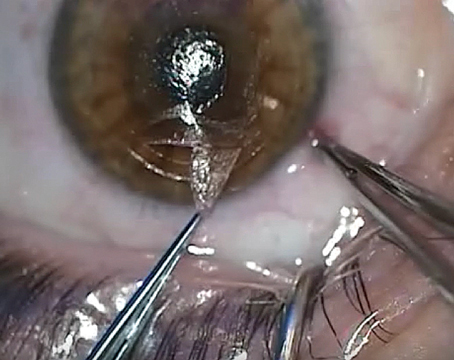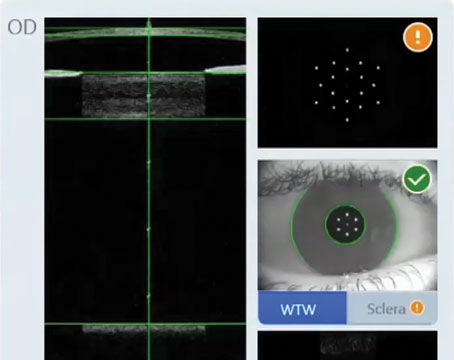If you're a refractive surgeon, you may not be making as much money as you can with LASIK. Missing hidden costs, trying to lower your price to compete with discounters and not placing high enough a value on custom LASIK can all contribute to lost revenue, say refractive surgeons and consultants. In this article, with the help of such experts, Review takes a look at these issues.
LASIK vs. Cataract
Though many surgeons get into LASIK because of declining reimbursement for cataract surgery, Overland Park, Kan., surgeon Dan Durrie says that, if you're not charging enough for LASIK, you may actually be making less revenue per case than you do with cataract surgery. He uses this demonstration as an object lesson in how not knowing all your costs can decrease your revenue.
A breakdown of costs directly associated with LASIK and cataract surgery provided by Dr. Durrie, appears in Table 1 (since it's a quick example, costs such as equipment depreciation and disposables weren't included).
 |
Dr. Durrie notes that, by including follow-up visits in the LASIK fee a patient pays, as well as the extra staff hours devoted to handling seminars and undergoing extra refractive surgery training, costs begin to add up more.
"Follow-up for LASIK is usually 12 months and is included in the fee for many surgeons," he notes. "However, for cataract surgery, any follow-up after three months is paid by the patient's insurer, and 'enhancements' (such as YAGs, IOL repositionings or exchanges) are also an additional fee that the patient pays; they aren't included in the global fee as they are in many LASIK practices.
"A surgeon may look at the example and protest, saying, 'But my laser center cost isn't really $750,'" he says. "In that case, he really has to look at what his other actual costs are: What are his staffing costs, supply costs, per-click [royalty] fees, the depreciation on his laser if he owns it or the lease fee if he doesn't? The purpose of the example is to make him stop a minute and start thinking about costs that he may not have considered."
Table 1. LASIK vs. Cataract Surgery Costs
LASIK Global Fee: $1,800
Cataract Global Fee: $1,860
Less:
Less:
ASC fee: $750
ASC fee: $940
Laser royalty: $150
Co-management (25 percent of eyes at 20 percent of the global fee): $90
Co-management (25 percent of eyes co-managed with 20-percent of surgeon fee): $35
Marketing cost: $250
Discounts (for friends, staff, ODs,
promotions, etc.): $90
Enhancement cost: $35
Patient financing (if you finance 30
percent of your patients): $45
Office overhead: 70 percent (typical for a refractive practice)
Office overhead: 60 percent
(typical for a cataract practice)
After costs, fee is now $127.50
After costs, fee is now $354
Costs to Watch
Chicago consultant Dan Wagster breaks refractive surgery costs down into four areas that should be considered when setting a price for LASIK. The average monetary costs attached to them are based on estimates from TLC Vision.
• Patient acquisition (advertising, seminars, staff who field calls, comanagement fees): $15,000-$20,000/year and higher (or $10,000-$15,000 if the practice just relies on patients coming through the door and maybe a database mailing once a year), depending upon how much advertising you do and how much it costs to advertise in your particular market.
• Clinic workup of the patient (qualifying patients for surgery, preop tests, equipment and technician costs): $20,000-$40,000/year depending on techs' salaries and how much time they devote to workups; plus around $2,000/month in depreciation cost for a $75,000 aberrometer spread over three years; $2 per color wavefront printout.
• The cost for the surgery (the laser, royalty fee, keratome, blades, surgical staff, intraoperative kits, facility fee): $190-$290/procedure for laser and maintenance; around $145 (Visx custom procedure royalty) or $250 (Alcon and Bausch & Lomb custom royalty) per procedure; $350/month for microkeratome and maintenance; $65/keratome blade; around $8,333/
month for staff of four making an average of $25,000/year; $8-$25/case for disposables kits; and around $750/case for a facility fee.
• Follow-up costs (similar to clinic workup costs above, though they vary depending on presence of complications and the amount of surgeon chair time needed): these include overhead and $15-$30/case for postop disposables kits.
In addition to these costs, Dr. Durrie recommends surgeons consider time and staff hours devoted to refractive surgery seminars, rent, liability insurance, employee benefits and paid time off (which builds up as a liability). The trick is determining what percentage of these costs to allocate to your practice's overall refractive surgery costs. The final percentage you use depends on how much of your practice is dedicated to refractive surgery. The more space and staff that are dedicated to refractive, the greater the percentage that should be added to your LASIK costs.
"We spend $1,500-$1,800 per year on cookies for seminars," says Dr. Durrie. "Everything has a cost."
• Comanaging, advertising and word of mouth. The experts say it helps to know how patients found out about you, and why they're coming through your door, because knowing that can help save money.
"Comanagement costs overlap with marketing costs," says Anna Austin, vice president of marketing for TLC Vision. "If you're comanaging some of your refractive patients, obviously you may pay more to the comanager than if you just followed up the patient yourself. But, that referral might have actually replaced a marketing cost you would have incurred if you had to generate that patient. So, though there's a cost in maintaining a relationship with that optometrist, such as helping him hold seminars in his office, it may be substantially less than doing any kind of advertising."
| Table 2. Average LASIK Costs Per Case |
| (Some costs assume a monthly volume of 30 cases) |
| Laser royalties -Conventional Visx $110 -Custom Visx $145 -Conventional Alcon/B&L $150 -Custom Alcon/B&L $250 Laser depreciation/lease $150-250 Laser maintenance $40 Microkeratome depreciation/maintenance $12 Microkeratome blade $65 Intralase $250-300 Intraoperative disposables $8-25 Postop drops/kit $15-30 Aberrometer depreciation $80 |
| Staff costs -Patient acquisition (lead generation, fielding calls; price could double if the practice has a dedicated surgical coordinator) $28-42 -Patient work-up (in clinic) $56-111 |
| Comanagement (if 25 percent are comanaged and fee is 20 percent of global fee of $1,800) $90 Facility fee (lease or fee to ASC owner) $415-750 Marketing and seminars $100-300 Surgeon chair time (assuming two surgeons working 20 days/month for 8 hours/day at $100,000 overhead and six patient visits at 10 min./visit): $300/patient Total costs, approx. $1,736 (or $2,011 w/Intralase) |
|
If enhancements are included (chair time, staff, laser royalty for enhancement, disposables; enhancement rate of 6 percent) $18 Total costs (incl. enhancement cost), approx. $1,754 |
| Cost data compiled from data provided by TLC Vision, Pacific Laser Eye Centers and refractive business consultant, Dan Wagster. |
Word-of-mouth advertising might cut your costs even more, once you've built an established reputation.
"You might have 30-50 percent of patients who come in from word of mouth," says Ms. Austin. "So, after you've spent x amount of dollars in marketing costs per procedure, you may have a number of patients for whom the acquisition cost is much lower, because they were just referred to you by a friend." If a large portion of your patients are coming from word of mouth, then, you may be able to shave off some dollars from your per-procedure cost by scaling back on ads.
• Custom LASIK. Dr. Durrie warns not to fall into the trap of not charging more for advanced procedures like custom LASIK and Intralase in an effort to attract patients, because they have added costs that need to be considered.
"With custom LASIK, you have an expensive aberrometer that takes training and usually an extra employee to run, either a half or even a full-time equivalent person—you usually have to put your best tech on it," he says. "We're talking about a $35,000 to $50,000 salary just assigned to that machine. So, if you're going to do a couple hundred cases per month, it wouldn't have just cost you $50,000 for the device. You've got to depreciate it because it will go out of date in a year or two, pay a service contract of $5,000 per year, pay the staff to train on it, come up with a marketing campaign in the community to announce that you're doing custom lasers, hold a seminar and pay about $150 more per use as a royalty. If you don't charge more, these costs may wipe out any small profit you may have been making before custom."
• Enhancements. When it comes to assigning costs and setting prices, the subject of enhancements is a large gray area. Some surgeons believe in charging for them and some don't.
Some feel that the follow-up visits involved with enhancements have costs that should be factored in somewhere in your LASIK pricing, either by being built into the price of primary procedures or through an outright additional charge for enhancements.
"Surgeons should think, 'When I do an enhancement, what does it cost me to go to the laser and use the facility again?'" he says. "And then, they have to do preop and postop exams, and one-month and two-month exams. By then, they've got another $250 worth of costs involved in the enhancement, in addition to the royalty the laser company charges. Enhancements may cost surgeons $600-$700 out of their pockets to do, but they may be doing them for free." To help offset this cost, he factors about $25 into each primary case, assuming an enhancement rate of 6 percent.
Randall Fuerst, OD, CEO of Pacific Laser Eye Centers, a company that owns and operates nine laser centers in California and Nevada, says that these postop enhancement follow-ups do cost you, but that charging for them may still be a prickly issue.
"Surgeons have to look at what their chair time costs them," Dr. Fuerst, says. "The simple way to do this is to divide your overhead costs, such as rent, utilities, taxes, staff, marketing, et cetera, by the number of doctor days worked." As an example, he says if your overhead is $100,000 per month and you and your partner work 20 days each during the month, your cost per day is $100,000/40 = $2,500/day. If the office is open eight hours each day, then chair time is $2,500/8 = $312.50 per hour. Then, if your appointment slots are in 10-minute increments, the cost per retreatment visit will be $312.50/6 = $52. Since a sequence of retreatment visits will usually include seven visits, the follow-up alone might cost $365 per enhancement. He says that it still may not be a good idea to charge for enhancements, though, in order to preserve whatever goodwill you still have with the patient. "You may not want to charge for it, because it could cost you more in terms of lost potential patients," he says.
Mr. Wagster, on the other hand, doesn't think you can assign costs for enhancement chair time to your LASIK procedures, because you already have the staff in place to see these patients.
"The key is whether or not you go past the maximum of your practice capacity," he says. "Those follow-up costs actually don't come out of a doctor's pocket if he has the capacity to see those patients anyway." He admits, though, that these could become hard costs if a practice has to see other patients in addition to refractive ones, since there may be some other revenue-generating opportunities lost.
Ms. Austin, of TLC, and her colleague, Rikki Bradley, executive vice president for operations and clinical services, think it's best not to build the cost of enhancements into your LASIK price, since paying for them yourself is a motivation to keep your enhancement rate down.
"We think it's reasonable to include enhancements in the initial price for LASIK," says Ms. Bradley, "because it's an area for continuous improvement that the surgeon needs to focus on. As soon as they factor in an extra cost for enhancements into the global fee, then they're not worried if they've got a 10-percent enhancement rate. But, the reality is that there's a hidden cost in terms of negative word of mouth. The surgeons should just consider the enhancement follow-up visits as part of their existing capacity and strive to be under the standard, published rate of enhancements."
R. Bruce Grene, MD, of Wichita, Kan., doesn't buy the "excess capacity" argument. His practice charges 25 percent ($500) of the original LASIK fee for any enhancements done in the first two postop years, and half the fee ($1,000) for enhancements after that.
He says if you have staff that aren't doing anything and are available for enhancement follow-ups, you probably have too much staff.
"There are other things one can do with one's time and resources rather than chronically run staff costs well in excess of demand," he says. Instead, he says, he adjusts staff in response to the workload of the practice.
Setting a Price
Once you've allocated all the costs involved, you can set a price that lets you reach the revenue goals you've set. If you plan to keep up with technology and offer the very best to your patients, Dr. Durrie doesn't think it's wise to set a price below approximately $2,000 or $2,250 per eye.
"I know doctors who have recently begun to offer customized treatments and added an Intralase and are charging below $2,000 per eye, and are losing money on every case and don't even know it," says Dr. Durrie. "A surgeon who charges less might say, 'Well, patients won't pay it,' or, 'I'll just charge this number because the guy down the street charges it.' You have to look at what it costs you to provide care and what a reasonable return on investment would be. I charge $2,850 per eye for custom LASIK with Intralase [for making flaps] and I, personally, make less than $200 per eye. Fortunately, I do a bunch of them, so I make money at the end of the year."
If a surgeon is hesitant to raise prices for fear of patient backlash, he says, "We used to charge $2,500 for a Summit laser with a 5-mm zone with no astigmatism correction and no transition zones and patients paid that. Now, we're giving them a wavefront-guided, custom surgery, and some surgeons feel you need to give it at half the price of a procedure that wasn't nearly as good."
• Custom costs more. Ms. Bradley says that, when approaching pricing of conventional and custom LASIK, surgeons go one of two ways: Around 80 percent of surgeons usually charge $350-$500 more per eye for custom, while the rest increase their price for both procedures to a flat rate.
"The surgeons who price them differently want patients to understand the differences between conventional and custom, and have put mechanisms in place to help educate patients," says Ms. Bradley. "They want word of mouth to spread about custom. These surgeons are usually in highly competitive markets, so they have to have a variety of price points to attract a variety of patient profiles.
"The latter group, who have chosen to charge a flat fee, don't want to have to explain the difference between custom and conventional to patients, and think patients probably won't understand it. These surgeons also feel bullish about raising their overall price in their markets."
Ultimately, Dr. Grene thinks that keeping LASIK prices relatively high, in the $2,000 range, is the right strategy for physicians due to the level of service they will provide patients.
"Once you make price the operative point, you turn LASIK into a commodity and you're going to lose," he says, "because you will be unwilling to provide the kind of system that commodity health care demands. Good surgeons will want to provide a level of care and attention to the patient that's consistent with their standards of medicine … Because of that, dealing on price becomes a fool's game in medical services."






